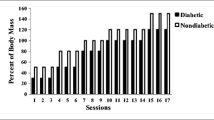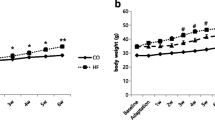Abstract
High-fat feeding activates components of the pro-inflammatory pathway and increases co-immunoprecipitation of suppressor of cytokine signalling (SOCS)-3 with both the insulin receptor (IR)-β subunit and IRS-1, which together contribute to keeping PI-3 kinase from being fully activated. However, whether aerobic training reverses these impairments is unknown. Sprague-Dawley rats were fed a chow (CON, n = 8) or saturated high-fat (n = 16) diets for 4 weeks. High-fat-fed rats were then allocated (n = 8/group) to either sedentary (HF) or aerobic exercise training (HFX) for an additional 4 weeks after which all animals underwent hind limb perfusions. Insulin-stimulated red quadriceps 3-O-methylglucose transport rates and PI-3 kinase activity were greater (p < 0.05) in CON and HFX compared to HF. IRS-1 tyrosine phosphorylation was increased (p < 0.05) and IRS-1 serine 307 phosphorylation was decreased (p < 0.05) in HFX compared to HF. IR-β subunit co-immunoprecipitation with IRS-1 was increased in HFX compared to HF. SOCS-3 co-immunoprecipitation with both the IR-β subunit and IRS-1 was decreased (p < 0.05) in HFX compared to HF. IKKα/β serine phosphorylation, and IκBα serine phosphorylation were decreased (p < 0.05) while IκBα protein concentration was increased in HFX compared to HF. By decreasing the association of SOCS-3 with both the IR-β subunit and IRS-1 the interaction between IRS-1 and the IR-β subunit was normalized in the HFX, and may have contributed to skeletal muscle PI-3 kinase being fully activated by insulin. Additionally, the reduction in IKKα/β serine phosphorylation in HFX may have contributed to decreasing IRS-1 serine phosphorylation, and in turn, promoted the normalization of insulin-stimulated activation of PI-3 kinase.








Similar content being viewed by others
References
Bhatt BA, Dube JJ, Dedousis N, Reider JA, O’Doherty RM (2006) Diet-induced obesity and acute hyperlipidemia reduce IκBα levels in rat skeletal muscle in a fiber-type dependent manner. Am J Physiol Regul Integr Comp Physiol 290:R233–R240
Boden G, She P, Mozzoli M, Cheung P, Gumireddy K, Reddy P, Xiang X, Luo Z, Ruderman N (2005) Free fatty acids produce insulin resistance and activate the proinflammatory nuclear factor-kB pathway in rat liver. Diabetes 54:3458–3465
Borst SE, Conover CF (2005) High-fat diet induces increased tissue expression of TNF-α. Life Sci 77:2156–2165
DiDonato JA, Hayakawa M, Rothwarf DM, Zandi E, Karin M (1997) A cytokine-responsive IkappaB kinase that activates the transcription factor NF-kappaB. Nature 388:548–554
Emanuelli B, Peraldi P, Filloux C, Sawka-Verhelle D, Hilton D, Van Obberghen E (2000) SOCS-3 is an insulin-induced negative regulator of insulin signaling. J Biol Chem 275:15985–15991
Emanuelli B, Peraldi P, Filloux C, Chavey C, Friedinger K, Hilton DJ, Hotamisligil GS, Van Obberghen E (2001) SOCS-3 inhibits insulin signaling and is up-regulated in response to tumor necrosis factor-alpha in the adipose tissue of mice. J Biol Chem 276:47944–47949
Gao Z, Hwang D, Bataille F, Lefevre M, York D, Quon MJ, Ye J (2002) Serine phosphorylation of insulin receptor substrate 1 by inhibitor kappa B kinase complex. J Biol Chem 277:48115–48121
Hansen PA, Han DH, Marshall BA, Nolte LA, Chen MM, Mueckler M, Holloszy JO (1998) A high fat diet impairs stimulation of glucose transport in muscle. Functional evaluation of potential mechanisms. J Biol Chem 273:26157–26163
Hawley JA, Lessard SJ (2008) Exercise training-induced improvements in insulin action. Acta Physiol (Oxf) 192:127–135
Herr HJ, Bernard JR, Reeder DW, Rivas DA, Limon JJ, Yaspelkis BB III (2005) Insulin-stimulated plasma membrane association and activation of Akt2 and, aPKC ζ and λ in high fat fed rodent skeletal muscle. J Physiol 565:627–636
Hirosumi J, Tuncman G, Chang LF, Gorgun CZ, Uysal KT, Maedda K, Karin M, Hotamisligil GS (2002) A central role for JNK in obesity and insulin resistance. Nature 420:333–336
Howard JK, Flier JS (2006) Attenuation of leptin and insulin signaling by SOCS proteins. Trends Endocrinol Metab 17:365–371
Itani S, Ruderman N, Schmeider F, Boden G (2002) Lipid-induced insulin resistance in human muscle is associated with changes in diacylglycerol, protein kinase C, and IkappaB-alpha. Diabetes 51:2005–2011
Ivy JL, Brozinick JT Jr, Torgan CE, Kastello GM (1989) Skeletal muscle glucose transport in obese Zucker rats after exercise training. J Appl Physiol 66:2635–2641
Kim CH, Youn JH, Park JY, Hong SK, Park KS, Park SW, Suh KI, Lee KU (2000) Effects of high-fat diet and exercise training on intracellular glucose metabolism in rats. Am J Physiol Endocrinol Metabol 278:E977–E984
Kim JK, Kim Y-J, Fillmore JJ, Chen Y, Moore I, Lee J, Yuan M, Li ZW, Karin M, Perret P, Shoelson SE, Shulman GI (2001) Prevention of fat-induced insulin resistance by salicylate. J Clin Invest 108:437–446
Kim JK, Fillmore JJ, Sunshine MJ, Albrecht B, Higashimori T, Kim DW, Liu ZX, Soos TJ, Cline GW, O’Brien WR, Littman DR, Shulman GI (2004) PKC-theta knockout mice are protected from fat-induced insulin resistance. J Clin Invest 114:823–827
Kraegen EW, Storlein LH, Jenkins AB, James DE (1989) Chronic exercise compensates for insulin resistance induced by a high-fat diet in rats. Am J Physiol Endocrinol Metabol 256:E242–E249
Krisan AD, Collins DE, Crain AM, Kwong CC, Singh MK, Bernard JR, Yaspelkis BB III (2004) Resistance training enhances components of the insulin signaling cascade in normal and high-fat-fed skeletal muscle. J Appl Physiol 96:1691–1700
Lessard SJ, Rivas DA, Chen ZP, Bonen A, Febbraio MF, Reeder DW, Kemp BE, Yaspelkis BB III, Hawley JA (2007) Tissue-specific effects of Rosiglitazone and exercise in the treatment of lipid-induced insulin resistance. Diabetes 56:1856–1864
Ronn SG, Billestrup N, Mandrup-Poulsen T (2007) Diabetes and suppressors of cytokine signaling proteins. Diabetes 56:541–548
Ropelle ER, Pauli JR, Prada PO, de Souza CT, Picardi PK, Faria MC, Cintra DE, Fernanda de A Fernandes M, Flores MB, Vellose LA, Saad MJA, Carvalheira JBC (2006) Reversal of diet-induced insulin resistance with a single bout of exercise in the rat: the role of PTP1B and IRS-1 serine phosphorylation. J Physiol 577:997–1007
Ruderman NB, Houghton CRS, Helms R (1971) Evaluation of the isolated perfused rat hindquarter for the study of muscle metabolism. Biochem J 124:639–651
Rui L, Yuan M, Frantz D, Shoelson S, White M (2002) SOCS-1 and SOCS-3 block insulin signaling by ubiquitin-mediated degradation of IRS1 and IRS2. J Biol Chem 277:42394–42398
Saito M, Lessard SJ, Rivas DA, Reeder DW, Hawley JA, Yaspelkis BB III (2008) Activation of atypical protein kinase Cζ toward TC10 is regulated by high-fat diet and aerobic exercise in skeletal muscle. Metabolism 57:1173–1180
Schmitz-Peiffer C (2002) Protein kinase C and lipid-induced insulin resistance in skeletal muscle. Ann N Y Acad Sci 967:146–157
Shoelson SE, Lee J, Yuan M (2003) Inflammation and the IKKβ/IκB/NF-κB axis in obesity- and diet-induced insulin resistance. Int J Obesity 27:S49–S52
Singh MK, Krisan AD, Crain AM, Collins DE, Yaspelkis BB III (2003) High-fat diet and leptin treatment alter skeletal muscle insulin-stimulated phosphatidylinositol 3-kinase activity and glucose transport. Metabolism 52:1196–1205
Spangenburg EE, Brown DA, Johnson MS, Moore RL (2006) Exercise increases SOCS-3 expression in rat skeletal muscle: potential relationship to IL-6 expression. J Physiol 572:839–848
Steinberg GR, Smith AC, Wormald S, Malenfant P, Collier C, Dyck DJ (2004) Endurance training partially reverses dietary-induced leptin resistance in rodent skeletal muscle. Am J Physiol Endocrinol Metab 286:E57–E63
Tremblay F, Lavigne C, Jacques H, Marette A (2001) Defective insulin-induced GLUT4 translocation in skeletal muscle of high fat-fed rats is associated with alterations in both Akt/Protein Kinase B and atypical Protein Kinase C (ζ/λ) activities. Diabetes 50:1901–1910
Ueki K, Kondo T, Kahn CR (2004a) Suppressor of cytokine signaling 1 (SOCS1) and SOCS-3 cause insulin resistance through inhibition of tyrosine phosphorylation of the insulin receptor substrate proteins by discrete mechanisms. Mol Cell Biol 24:5434–5446
Ueki K, Kondo T, Tseng YH, Kahn CR (2004b) Central role of suppressors of cytokine signaling proteins in hepatic steatosis, insulin resistance, and the metabolic syndrome in the mouse. Proc Natl Acad Sci 101:10422–10427
Um SH, Frigerio F, Watanaabe M, Picard F, Joaqui M, Sticker M, Fumagalli S, Allegrini PR, Kozma SC, Auwerx J, Thomas G (2004) Absence of S6K1 protects against age- and diet-induced obesity while enhancing insulin sensitivity. Nature 431:200–2005
Yaspelkis BB III, Ansari L, Ramey EA, Loy SF (1999a) Chronic leptin administration increases insulin-stimulated skeletal muscle glucose uptake and transport. Metabolism 48:671–676
Yaspelkis BB III, Castle AL, Ding Z, Ivy JL (1999b) Attenuating the decline in ATP arrests the exercise training-induced increases in muscle GLUT4 protein and citrate synthase activity. Acta Physiol Scand 165:71–79
Yaspelkis BB III, Davis JR, Saberi M, Smith TL, Jazayeri R, Singh M, Fernandez V, Trevino B, Chinookoswong N, Wang J, Shi ZQ, Levin N (2001) Leptin administration improves skeletal muscle insulin responsiveness in diet-induced insulin-resistant rats. Am J Physiol Endocrinol Metab 280:E130–E142
Yaspelkis BB III, Singh MK, Krisan AD, Collins DE, Kwong CC, Bernard JR, Crain AM (2004) Chronic leptin treatment enhances insulin-stimulated glucose disposal in skeletal muscle of high-fat fed rodents. Life Sci 74:1801–1816
Yaspelkis BB III, Lessard SJ, Reeder DW, Limon JJ, Saito M, Rivas DA, Kvasha I, Hawley JA (2007) Exercise reverses high-fat diet-induced impairments on compartmentalization and activation of components of the insulin signaling cascade in skeletal muscle. Am J Physiol Endocrinol Metabol 293:E941–E949
Yaspelkis BB III, Kvasha IA, Figueroa TY (2009) High-fat feeding increases insulin receptor and IRS-1 coimmunoprecipitation with SOCS-3, IKKα/β phosphorylation and decreases PI-3 kinase activity in muscle. Am J Physiol Regul Integr Comp Physiol 296:R1709–R1715
Yu CL, Chen Y, Cline GW, Zhang DY, Zong HH, Wang YL, Bergeron R, Kim JK, Cushman SW, Cooney GJ, Atcheson B, White MF, Kraegen EW, Shulman GI (2002) Mechanism by which fatty acids inhibit insulin activation of insulin receptor substrate-1 (IRS-1)-associated phosphatidylinositol 3-kinase activity in muscle. J Biol Chem 277:50230–50236
Yuan M, Konstantopoulos N, Lee J, Hansen L, Li Z, Karin M, Shoelson SE (2001) Reversal of obesity- and diet-induced insulin resistance with salicylates or targeted disruption of IkKb. Science 293:1673–1677
Acknowledgments
This study was supported by grants from the National Institutes of Health (GM-48680, GM-08395 and DK-57625).
Author information
Authors and Affiliations
Corresponding author
Additional information
Communicated by Martin Flueck.
Rights and permissions
About this article
Cite this article
Yaspelkis III, B.B., Kvasha, I.A., Lessard, S.J. et al. Aerobic training reverses high-fat diet-induced pro-inflammatory signalling in rat skeletal muscle. Eur J Appl Physiol 110, 779–788 (2010). https://doi.org/10.1007/s00421-010-1559-7
Accepted:
Published:
Issue Date:
DOI: https://doi.org/10.1007/s00421-010-1559-7




